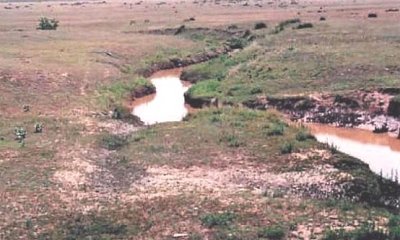
Draw 16-22" PZ
Scenario model
Current ecosystem state
Select a state
Management practices/drivers
Select a transition or restoration pathway
- Transition T1A More details
- Restoration pathway R2A More details
- Transition T2A More details
- Restoration pathway R3A More details
-
No transition or restoration pathway between the selected states has been described
Target ecosystem state
Select a state
State 1
Midgrass Dominant State



Description
The Midgrass Dominant State consists of a reference plant community having a mixture of tall and midgrasses with lesser amounts of shortgrass species along with a respectable amount of forbs and scattered woody plants as well as a midgrass dominant community of perennial midgrass community with scattered shrubs and trees.
Submodel
Description
This plant community is dominated by blue grama and buffalograss. There are a few pockets of western wheatgrass. False tarragon sagewort is beginning to increase. This plant community is overgrazed shortgrass dominant with a few half-shrubs and yucca invasion.
Submodel
Mechanism
Due to heavy continuous grazing and no fires, the Midgrass Dominant State transitions into a Shortgrass/Midgrass State.
Mechanism
With the implementation of prescribed grazing (over a three to five year period) and prescribed burning conservation practices, the Shortgrass/Midgrass State can revert back to the Midgrass Dominant State.
Relevant conservation practices
| Practice | External resources |
|---|---|
|
Prescribed Burning |
|
|
Prescribed Grazing |
Mechanism
Many years of abusive grazing practices with stocking rates exceeding the carrying capacity can transition the site to the shortgrass dominated state.
Constraints to recovery
The vigor of the most palatable grasses has declined and the sodbound shortgrasses remain. Recovery of this state, if possible, may take many years.
Mechanism
With the implementation of prescribed grazing, brush management, and prescribed burning conservation practices, the Degraded Shortgrass State can be reverted into the Shortgrass/Midgrass State.
Relevant conservation practices
| Practice | External resources |
|---|---|
|
Brush Management |
|
|
Prescribed Burning |
|
|
Prescribed Grazing |
Model keys
Briefcase
Add ecological sites and Major Land Resource Areas to your briefcase by clicking on the briefcase (![]() ) icon wherever it occurs. Drag and drop items to reorder. Cookies are used to store briefcase items between browsing sessions. Because of this, the number of items that can be added to your briefcase is limited, and briefcase items added on one device and browser cannot be accessed from another device or browser. Users who do not wish to place cookies on their devices should not use the briefcase tool. Briefcase cookies serve no other purpose than described here and are deleted whenever browsing history is cleared.
) icon wherever it occurs. Drag and drop items to reorder. Cookies are used to store briefcase items between browsing sessions. Because of this, the number of items that can be added to your briefcase is limited, and briefcase items added on one device and browser cannot be accessed from another device or browser. Users who do not wish to place cookies on their devices should not use the briefcase tool. Briefcase cookies serve no other purpose than described here and are deleted whenever browsing history is cleared.
Ecological sites
Major Land Resource Areas
The Ecosystem Dynamics Interpretive Tool is an information system framework developed by the USDA-ARS Jornada Experimental Range, USDA Natural Resources Conservation Service, and New Mexico State University.




